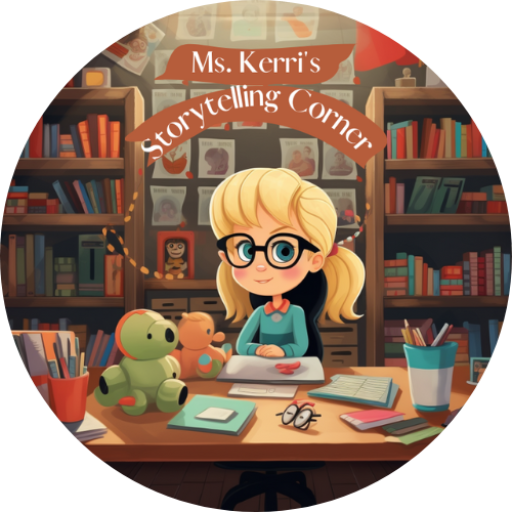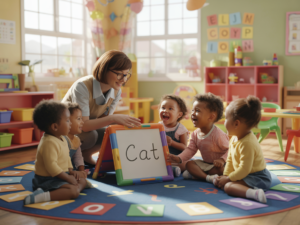
Morning routines are an important part of setting a positive tone for the day, especially for preschoolers. By incorporating fun and engaging activities into their morning routine, you can help ease them into their day and promote a sense of excitement and curiosity. Here are 10 fun morning routines to try with your preschooler.
Key Takeaways
- Start the day with a positive attitude
- Greet your child with a warm smile
- Engage in simple stretching exercises
- Dance to their favorite music
- Offer a variety of nutritious breakfast options
Wake Up with a Smile

Start the day with a positive attitude
Starting the day with a positive attitude can set the tone for the rest of the day. It’s important to create a welcoming and cheerful environment for your child as they wake up. Greet them with a warm smile and let them know that it’s going to be a great day. This simple gesture can make a big difference in their mood and outlook.
Greet your child with a warm smile
Starting the day with a warm smile sets a positive tone for your child’s morning. It shows them that they are loved and welcomed. A smile can make them feel safe and secure, ready to take on the day ahead. So, as soon as your child wakes up, greet them with a big, genuine smile. Let them know that you are happy to see them and excited for the day to begin.
Stretch and Move

Engage in simple stretching exercises
Stretching exercises are a great way to wake up your preschooler’s body and get them ready for the day ahead. Start by encouraging them to reach up high and touch the sky, stretching their arms as far as they can. Then, have them bend down and touch their toes, stretching their legs and back. You can also try some fun animal-inspired stretches, like pretending to be a cat and arching their back or imitating a tree and reaching their branches up to the sky.
To make stretching even more enjoyable, put on some upbeat music and turn it into a dance party! Encourage your child to move their body in different ways, like jumping, twirling, and shaking their arms and legs. Not only will this get their blood flowing, but it will also help improve their coordination and balance.
Remember to always listen to your child’s body and encourage them to stretch within their comfort zone. It’s important to start the day with gentle movements that promote flexibility and prepare their muscles for the activities ahead.
Dance to their favorite music
Engaging in dance activities with your preschooler is not only a fun way to start the day, but it also promotes physical movement and coordination. Put on their favorite music and encourage them to move their bodies to the rhythm. Dancing helps develop their gross motor skills and allows them to express themselves creatively. It’s a great opportunity for them to let loose and have a blast!
To make it even more exciting, you can create a dance routine together. Teach them simple steps and encourage them to add their own moves. This will not only enhance their coordination but also boost their confidence as they learn and perform the routine. Dancing is a wonderful way to bond with your child and create lasting memories.
Remember to join in the fun too! Show off your best dance moves and let your child see your enthusiasm. Dancing together creates a positive and interactive environment that will set the tone for the rest of the day.
So put on some music, get ready to groove, and have a dance party to kickstart your morning!
Healthy Breakfast Choices

Offer a variety of nutritious options
When it comes to breakfast, it’s important to provide your preschooler with a range of healthy choices. Variety is key to ensuring they get the nutrients they need to start their day off right. Offer a selection of fruits, whole grains, and protein-rich foods like eggs or yogurt. By including different options, you can introduce your child to new flavors and textures, while also ensuring they receive a balanced meal. Encourage your child to try different foods and engage them in the meal preparation process. This can help foster a positive relationship with food and promote healthy eating habits.
Involve your child in meal preparation
Meal preparation can be a fun and educational activity for preschoolers. Involving your child in the process not only teaches them important life skills, but also encourages them to try new foods and develop a healthy relationship with food. Here are some ways you can get your child involved in meal preparation:
- Let them choose ingredients: Give your child the opportunity to pick out fruits, vegetables, or other ingredients at the grocery store. This not only gives them a sense of ownership over the meal, but also exposes them to different types of foods.
- Wash and chop together: Show your child how to wash fruits and vegetables, and let them help with chopping (under close supervision). This teaches them about food hygiene and knife safety.
- Stir and mix: Allow your child to stir and mix ingredients together. This helps develop their fine motor skills and gives them a sense of accomplishment.
Tip: Encourage your child to taste the ingredients as they go along. This helps them become familiar with different flavors and textures.
By involving your child in meal preparation, you are not only making breakfast time more enjoyable, but also setting them up for a lifetime of healthy eating habits.
Creative Playtime

Encourage imaginative play
Imaginative play is a crucial part of a preschooler’s development. It allows them to explore their creativity, problem-solving skills, and social interactions. By providing your child with open-ended toys and materials, such as blocks, dolls, and dress-up clothes, you can encourage them to use their imagination and create their own stories and scenarios. Imaginative play also helps children develop their language and communication skills as they engage in pretend play and role-playing. It’s a wonderful way for them to express themselves and make sense of the world around them.
Provide art supplies for self-expression
Encouraging creativity and self-expression is an important part of a preschooler’s development. By providing art supplies, you can give your child the opportunity to explore their imagination and create unique masterpieces. Markers, crayons, and paints are great tools for little artists to express themselves. Set up a designated art area where your child can freely experiment with different materials and colors. Encourage them to use their hands, brushes, or even household objects to create textures and patterns.
Storytelling and Reading

Read a favorite story together
Reading a favorite story together is a wonderful way to bond with your preschooler and foster their love for books. Immerse yourselves in the magical world of storytelling as you embark on exciting adventures and meet fascinating characters. Choose books that are age-appropriate and capture your child’s imagination. Encourage your child to participate in the reading experience by asking questions, making predictions, and discussing the story. This interactive approach not only enhances their comprehension skills but also nurtures their creativity and critical thinking abilities.
Encourage your child to tell their own stories
Storytelling is a wonderful way for preschoolers to express their creativity and imagination. It helps them develop language skills, expand their vocabulary, and improve their listening and comprehension abilities. Encourage your child to tell their own stories by providing them with a variety of props and prompts. You can use puppets, stuffed animals, or even simple objects like blocks or toys to spark their imagination. Ask open-ended questions to prompt their storytelling, such as ‘What do you think happens next?’ or ‘Can you tell me a story about your favorite animal?’ This activity not only stimulates their imagination but also enhances their cognitive and emotional development.
Outdoor Exploration

Take a nature walk
Taking a nature walk is a wonderful way to engage your preschooler with the natural world around them. It allows them to explore and discover new things, while also providing an opportunity for physical activity. Encourage your child to observe the different plants, animals, and insects they come across during the walk. Point out interesting features and ask questions to stimulate their curiosity. Nature walks can also be a great time to talk about the importance of taking care of the environment and respecting nature.
Play in the backyard or local park
Playing outdoors is a great way for preschoolers to burn off energy and explore their surroundings. Whether it’s running around in the backyard or visiting a local park, outdoor play offers numerous benefits for young children. Fresh air and sunshine provide essential vitamin D, while the wide open spaces allow for freedom of movement and physical activity. It’s also an opportunity for children to connect with nature and learn about the environment. Encourage your child to engage in imaginative play outdoors, whether it’s pretending to be a superhero or building a fort with sticks and leaves. Nature walks are another fun activity that can help children develop their observation skills and appreciation for the natural world.
Music and Movement

Sing and dance to lively tunes
Start the day off on a high note by singing and dancing to lively tunes with your preschooler. Music has a magical way of energizing and uplifting our spirits, and it’s no different for little ones. Engage their senses and ignite their imagination as you groove to their favorite songs.
- Create a playlist of upbeat and catchy tunes that your child loves. It could be nursery rhymes, children’s songs, or even your own dance party mix.
- Encourage your child to move their body freely and express themselves through dance. Let them explore different movements and rhythms, and don’t be afraid to join in the fun!
- Use props like scarves, ribbons, or musical instruments to add an extra element of excitement to the dance party.
Tip: Dancing together not only promotes physical activity but also enhances coordination, balance, and gross motor skills. It’s a fantastic way to bond with your child and start the day with joy and laughter.
So put on your dancing shoes, turn up the volume, and let the music guide you and your preschooler into a day filled with rhythm and happiness!
Play musical instruments together
Playing musical instruments together is a wonderful way to bond with your preschooler while also fostering their creativity and love for music. Music has been shown to have numerous benefits for children, including improving cognitive skills, enhancing language development, and boosting emotional well-being.
To make the most of this activity, start by introducing your child to different musical instruments. Let them explore the sounds and textures of each instrument, and encourage them to experiment with creating their own melodies. Encourage them to use their imagination and express themselves through music.
You can also incorporate simple rhythm games into your musical playtime. Clap or tap along to a beat, and encourage your child to follow along. This helps develop their sense of rhythm and coordination.
Remember, the goal is not to create a perfect performance, but rather to have fun and enjoy the process of making music together. So grab some instruments and let the music begin!
Mindfulness and Relaxation

Practice deep breathing exercises
Deep breathing exercises are a wonderful way to help preschoolers calm their minds and bodies. By taking slow, deep breaths, children can learn to regulate their emotions and reduce stress. Deep breaths can be practiced anywhere, whether it’s in the comfort of their bedroom or during a busy day at preschool. Encourage your child to take a moment to pause and take a few deep breaths whenever they feel overwhelmed or anxious.
To make deep breathing exercises more engaging, you can introduce fun visualizations. For example, ask your child to imagine they are blowing out candles on a birthday cake or blowing away a cloud of worries. This can make the practice more enjoyable and help them focus on their breath.
Here are a few simple steps to guide your child through a deep breathing exercise:
- Find a comfortable position, either sitting or lying down.
- Close their eyes or focus on a fixed point in front of them.
- Inhale slowly through their nose, counting to four.
- Hold their breath for a moment.
- Exhale slowly through their mouth, counting to four.
- Repeat this process several times, gradually increasing the count.
Remember, deep breathing exercises can be a valuable tool for preschoolers to manage their emotions and find a sense of calm. Encourage them to practice regularly and make it a part of their daily routine.
Try simple yoga poses
Yoga is a wonderful way for preschoolers to practice mindfulness and relaxation. By engaging in simple yoga poses, children can learn to focus their attention and calm their minds. It also helps improve flexibility, strength, and coordination. Child’s Pose is a great starting point for young children, as it allows them to rest and relax. Tree Pose is another fun pose that helps improve balance and concentration. Encourage your child to explore different poses and make it a playful and enjoyable experience.
Mindfulness and relaxation are important practices for maintaining mental and emotional well-being. By taking the time to focus on the present moment and engage in calming activities, such as deep breathing exercises or meditation, individuals can reduce stress and promote a sense of inner peace. These practices can be especially beneficial in today’s fast-paced world, where many people feel overwhelmed and constantly connected. If you’re looking to incorporate mindfulness and relaxation into your daily routine, visit Ms. Kerri’s Story Telling Corner. Our website offers a variety of resources and articles on mindfulness techniques, relaxation exercises, and personal stories that inspire and uplift. Take a moment for yourself and explore the power of mindfulness and relaxation at Ms. Kerri’s Story Telling Corner.
Conclusion
In conclusion, establishing a fun and engaging morning routine for preschoolers can set the tone for a positive and productive day. By incorporating activities that promote learning, creativity, and physical movement, parents and caregivers can help ease their little ones into the day ahead. Remember to be flexible and adapt the routine to suit your child’s interests and needs. With these 10 fun morning routines, you can create a joyful and stimulating environment that will make mornings enjoyable for both you and your preschooler.
Frequently Asked Questions
How long should each morning routine activity last?
The duration of each activity can vary depending on your child’s interest and attention span. It is recommended to keep each activity between 10-15 minutes to maintain engagement.
Can I modify the morning routine based on my child’s preferences?
Absolutely! It’s important to tailor the morning routine to your child’s interests and needs. Feel free to incorporate activities that your child enjoys and make adjustments as necessary.
What if my child is not a morning person and has difficulty waking up?
If your child struggles with waking up in the morning, try gradually adjusting their bedtime routine to ensure they are getting enough sleep. Additionally, incorporating activities they enjoy into the morning routine may help motivate them to wake up.
Are there any specific breakfast foods that are recommended for preschoolers?
It is important to offer a variety of nutritious options for breakfast. Some recommended foods for preschoolers include whole grains, fruits, vegetables, and dairy products. Avoid sugary cereals and opt for healthier alternatives.
How can I encourage my child to engage in imaginative play?
To encourage imaginative play, provide open-ended toys and materials that allow your child to use their creativity. You can also join in the play and provide prompts or suggestions to spark their imagination.
Can I incorporate technology into the morning routine?
While it’s important to limit screen time, you can incorporate technology in a balanced way. For example, you can use educational apps or watch educational videos together as part of the morning routine.

Ms. Kerri’s Corner provides a exciting virtual space for preschool learning. Through a variety of engaging activities, she exposes young minds to early math, literacy, science and social-emotional skills in a developmentally appropriate way. Centers for blocks, art, books and music allow children to explore hands-on learning at their own pace. Guided lessons subtly introduce number sense, letter sounds and narrative thinking. Careful observation gives insight into each child’s progress across domains. Viewers are also invited to participate, reinforcing that their ideas are valued. By making learning fun yet purposeful, Ms. Kerri lays the groundwork for future academic success while fostering creativity and imagination. Her program offers preschoolers valuable screen-based learning experiences.







